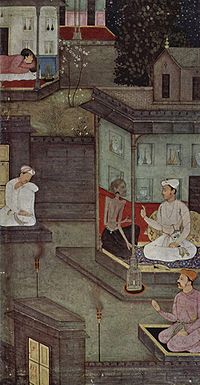Yoga Vasishtha
- Yoga Vasishtha
-

Représentation tirée d’un manuscrit datant de 1602
Le Yoga Vasishtha ou Yogavāsiṣṭha[1] (devanāgarī: योगवासिष्ठ)[2] est un texte sanskrit de la philosophie indienne āstika[3] composé entre le VIe ou le VIIes[4] et le XIIes ap. J.-C. . Le texte se présente sous la forme d'un discours entre Vasishtha et le jeune prince Rāma.
Structure du texte
Le texte qui comprend 29000 vers est divisé en six parties et 458 chapitres. Les six parties ou sections sont dans l'ordre:
- Vairagya Khanda (Renoncement au monde).
- Mumukshu Khanda (Aspiration à la délivrance).
- Utpatti Khanda (Création ou production - liée au mental -) .
- Sthiti Khanda (Existence).
- Upasama Khanda (Cessation - agitations du mental -).
- Nirvana Prakarama (Extinction ou libération).
Notes et références
Bibliographie
- The Supreme Yoga: Yoga Vatistha. Venkatesananda. Motilal Banarsidass Publ., 2003. (ISBN 9788120819757)
Wikimedia Foundation.
2010.
Contenu soumis à la licence CC-BY-SA. Source : Article Yoga Vasishtha de Wikipédia en français (auteurs)
Regardez d'autres dictionnaires:
yóga-vāsishṭha — योगवासिष्ठ … Indonesian dictionary
Vasishtha — ou Vasiṣṭha (devanāgarī: वसिष्ठ) est dans la mythologie hindoue un des saptarshi (Sept grands sages ou rishi) de l ère (manvantara) de Svāyaṃbhuva[1]. Notes et références ↑ The Sanskrit Heritage Dictionary de Gérard Huet Voir aussi … Wikipédia en Français
Yoga Vasistha — A painting from the Yoga Vasistha manuscript, 1602 Yoga Vasistha (Sanskrit: योग वासिष्ठ) (also known as Vasistha s Yoga) is a Hindu spiritual text traditionally attributed to Valmiki. It recounts a discourse of the sage Vasistha to a … Wikipedia
Siddha Yoga — is a new religious movement [cite web|url=http://religiousmovements.lib.virginia.edu/essays/miller2003.htm#1965|title=The New Religious Movements Homepage @The University of Virginia|accessdate=2007 03 18 Religious Movements in the United States… … Wikipedia
Vasistha — (Sanskrit: वसिष्ठ), in Hindu mythology was one of the Saptarishis (Seven Great Sages Rishi) in the seventh, i.e the present Manvantara,cite book |title=Mahānirvāna Tantra: Tantra of the Great Liberation |publisher=Luzac Co |location=London |first … Wikipedia
Swami Jyotirmayananda — was born in Dumari, Saran District, Bihar, India on 3 February 1931. He is a prominent, current day teacher of spiritual Hindu philosophy, and author of over 40 books [http://www.yrf.org/bookform.html Online Book Store on All Aspects of Yoga… … Wikipedia
Tamraparni — is an ancient region of southern India, corresponding to the area of a Tamraparni river, in Tirunelveli, Tamil Nadu. Now it is called as Thamirabarani River. Alternatively, it is also supposed to correspond to the area of Sri Lanka, Tamraparni… … Wikipedia
Nisargadatta Maharaj — Sri Nisargadatta Maharaj Born 17 April 1897(1897 04 17) Bombay (Mumbai), Maharashtra … Wikipedia
La ciencia de los siete cultivos — El Sadhana tattva (la verdad acerca de la práctica espiritual), también conocido como La ciencia de los siete cultivos es una obra escrita en inglés por Swami Sivananda. A continuación se presentan algunas recomendaciones, traducidas del inglés.… … Wikipedia Español
Versions of Ramayana — Depending on the methods of counting, as many as three hundred[1][2] versions of the Indian epic poem, the Ramayana, are known to exist. The oldest version is generally recognized to be the Sanskrit version attributed to the sage Valmiki. The… … Wikipedia

